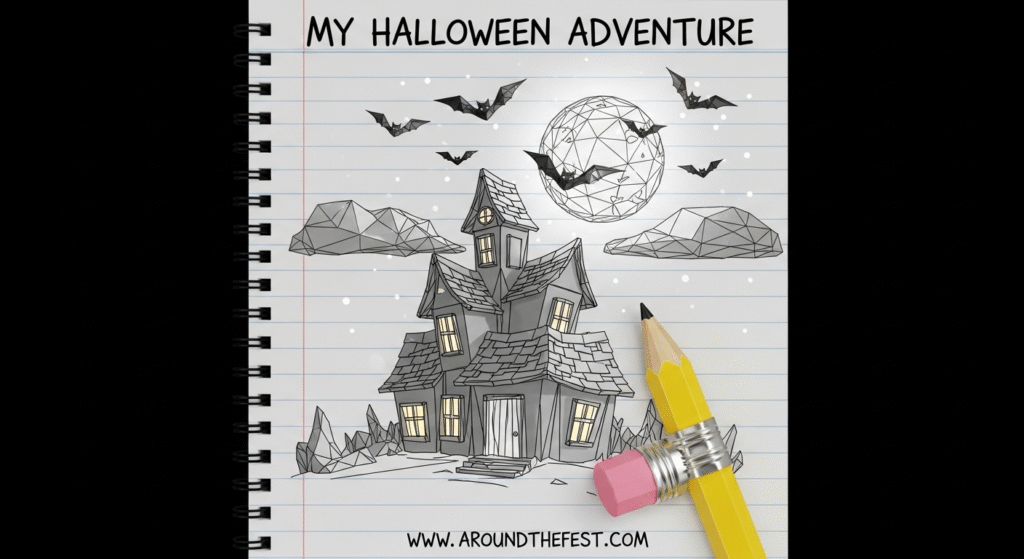Halloween Essay in English – Festival for Kids & Students
This Halloween Essay in English uncovers how modern Halloween traditions—colorful, creative, and full of symbolic meaning—have fascinating roots in history. In this section of the essay, we explore how today’s fun customs like costumes, pumpkin carving, and trick-or-treating evolved from spiritual beliefs and social rituals.
Shadows of a thousand years rise again unseen, voices whisper in the trees, ‘Tonight is Halloween!’” – Dexter Kozen
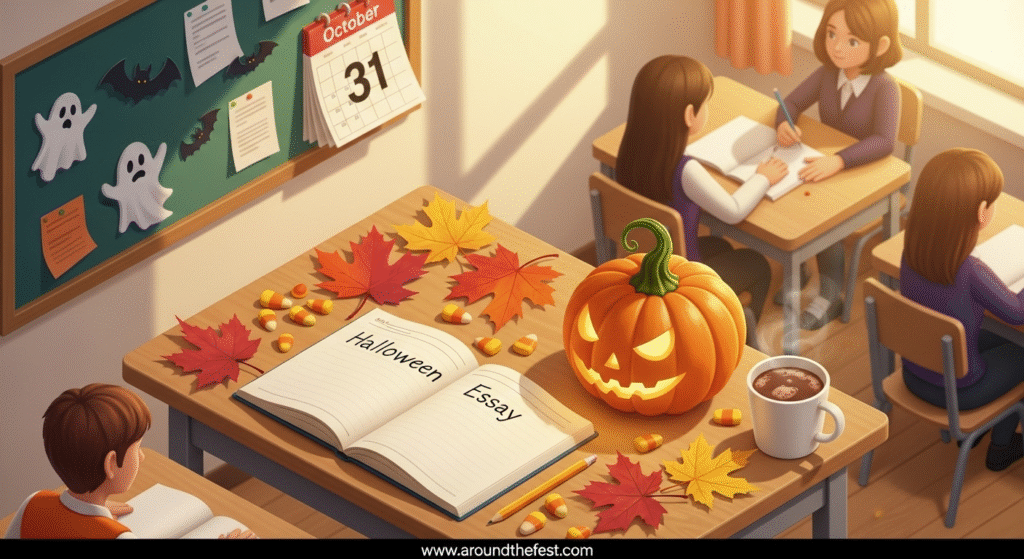 Modern Halloween traditions are colorful, creative, and full of symbolic meaning—but each has a fascinating backstory rooted in history. In this section of the Halloween Essay in English, we explore how today’s fun customs like costumes, pumpkin carving, and trick-or-treating evolved from spiritual beliefs and social rituals.
Modern Halloween traditions are colorful, creative, and full of symbolic meaning—but each has a fascinating backstory rooted in history. In this section of the Halloween Essay in English, we explore how today’s fun customs like costumes, pumpkin carving, and trick-or-treating evolved from spiritual beliefs and social rituals.
By reading this Halloween Festival Essay in English, you’ll discover how Halloween evolved, what it represents today, and why it remains a powerful cultural celebration.
Ancient Beginnings in the Halloween Essay in English: Traditions of Samhain
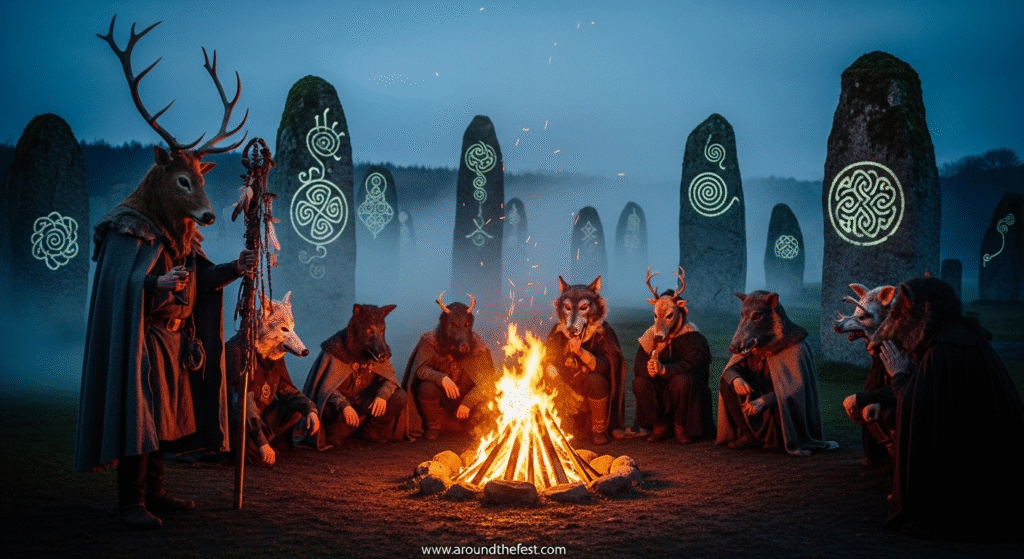
Long ago, Celtic communities marked the seasonal transition from harvest to winter with a festival called Samhain, observed around October 31. On that night, people believed that the living world and spirit realm briefly overlapped. To honor ancestors and protect their homes, they built bonfires, prepared food offerings, and wore masks or animal skins as a disguise strategy.
Besides these rituals, families sometimes set a place at their dinner table for departed relatives. They played quiet games with apples or nuts, interpreting results as fortune-telling or spiritual signs. These practices show how camping the past was—and how Halloween’s focus on mystery and remembrance began.
Christianity’s Influence on Halloween: A Cultural Shift in the Halloween Essay
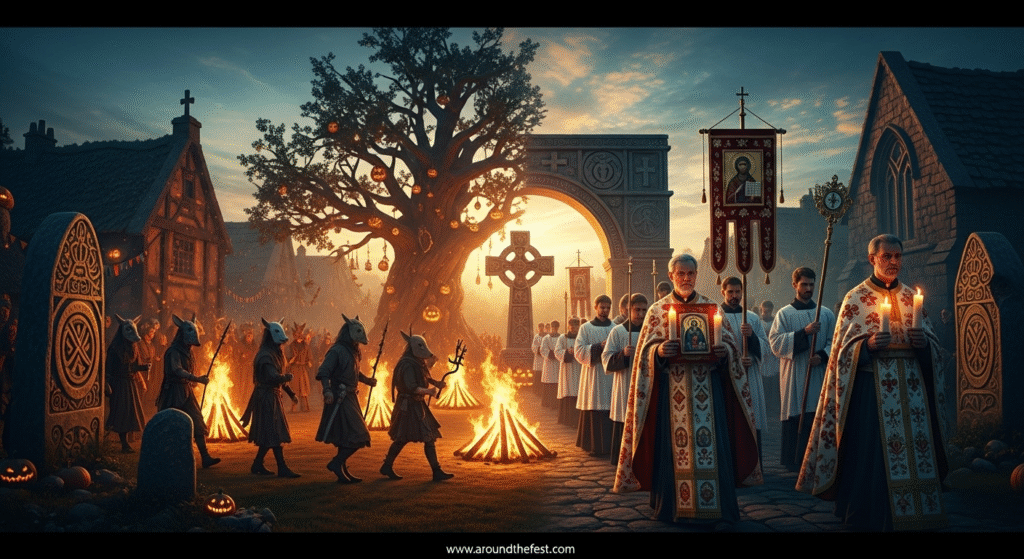
With the arrival of Christianity, these traditional October celebrations were adapted into religious observances. A church holiday honoring saints was moved to November 1, shifting focus from spirits to reverence. However, many local traditions—like costume wearing, fire lighting, and community gatherings—continued, giving rise to what became known as Halloween.
With the rise of Christianity, the ancient Celtic festival of Samhain began to merge with Christian observances like All Saints’ Day.
This blending allowed many old traditions—like bonfires and costumes—to survive, now wrapped in new religious meaning.
This blending created a holiday that kept both cultural memory and spiritual significance, making Halloween a uniquely layered observance.
Modern Halloween Traditions and Their Origins – A Halloween Festival Essay Insight
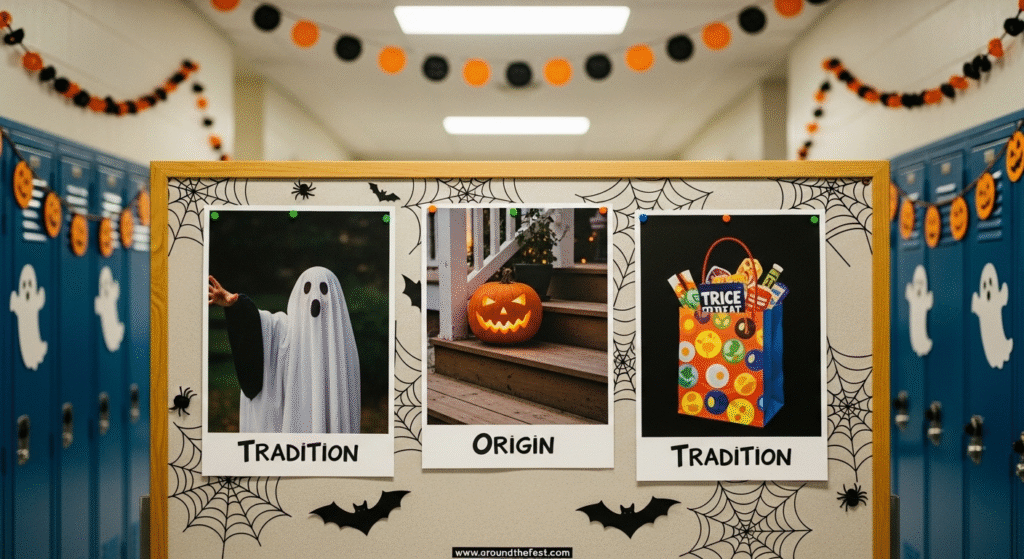 Costumes: From Disguise to Self-Expression
Costumes: From Disguise to Self-Expression
Costumes originally served as disguises to blend with wandering spirits. Over time, the custom transformed into playful creativity, letting kids and adults dress as ghosts, superheroes, or mythical creatures. Today, costume-making and design are major ways people express personality and cultural trends.
Jack-o’-Lanterns: Folklore Transformed
In early times, people carved faces into root vegetables like turnips or potatoes to ward off spirits. When settlers found pumpkins in North America, they adopted them instead—turning a warning symbol into a festive decoration. Carving pumpkins now encourages artistic expression and local tradition.
Trick-or-Treating: A Community Ritual
Ancient customs involved travelers or villagers seeking food or candles from neighbors in exchange for prayers or performances. Over the centuries, this evolved into children wearing costumes, saying “trick or treat,” and collecting candy door-to-door. It remains one of the most beloved activities, strengthening neighborhood connections.
Exploring Key Halloween Symbols
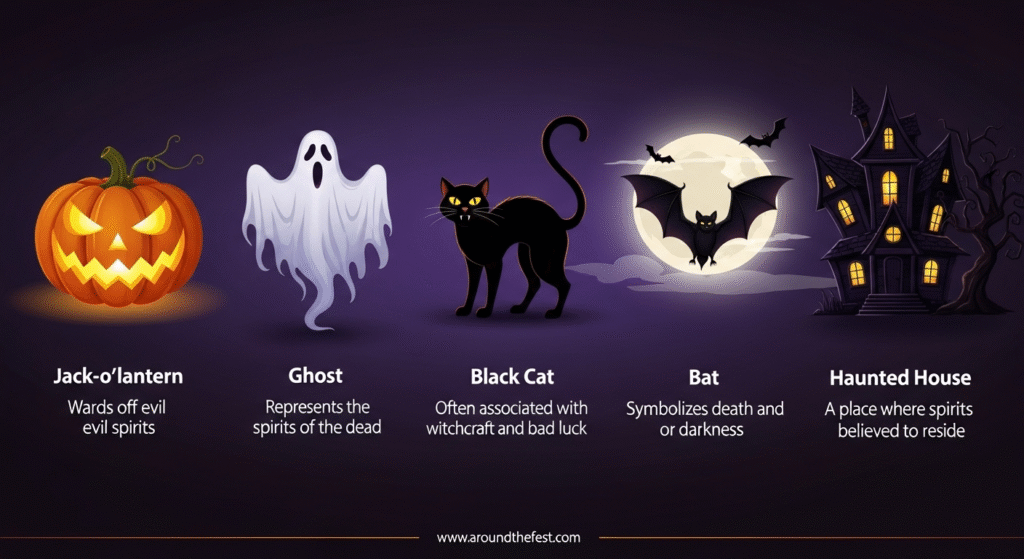 These items reflect how Halloween is rooted in ancient purpose but shaped for modern enjoyment.
These items reflect how Halloween is rooted in ancient purpose but shaped for modern enjoyment.
Halloween Around the World – A Global Look in This Halloween Essay in English
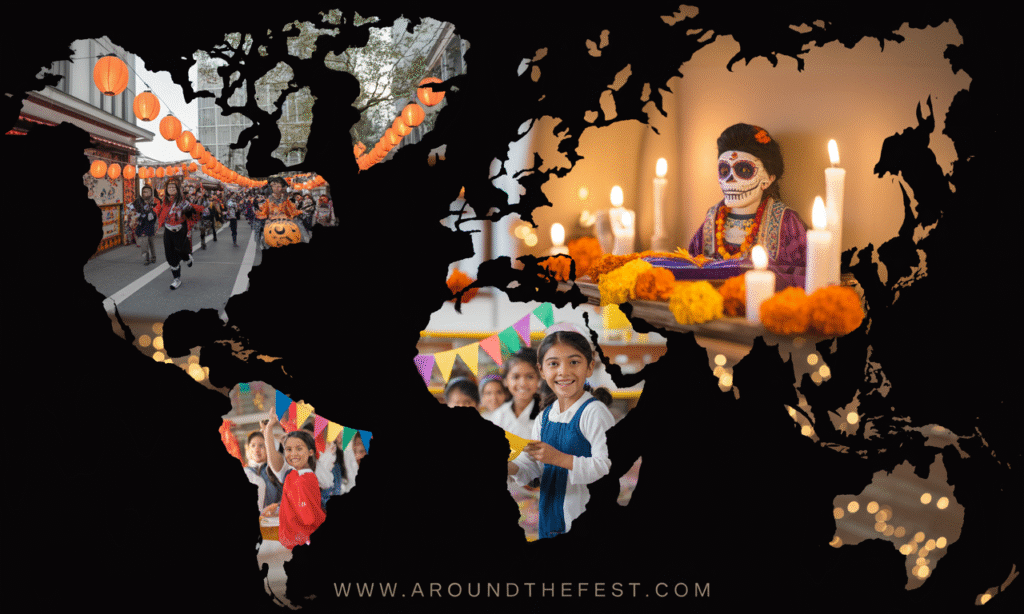
United States & Canada
Here, neighborhoods shine with elaborate home decorations, costume parties, and nighttime events. Halloween becomes a community blockbuster every October.
Mexico
While not called Halloween, Day of the Dead shares the same season and focus: honoring the departed with altars, music, and family gatherings.
Great Britain & Ireland
Many rural areas still observe traditional bonfires, apple games, and storytelling nights—connecting back to early customs.
Japan & India
In Japan, Halloween is celebrated through mass costume events in cities, with less spiritual meaning and more performance energy. In India, school and community celebrations shape Halloween into fun, themed parties.
These regional differences show how Halloween adapts to local cultures while maintaining its core themes.
Halloween’s Economic and Social Role
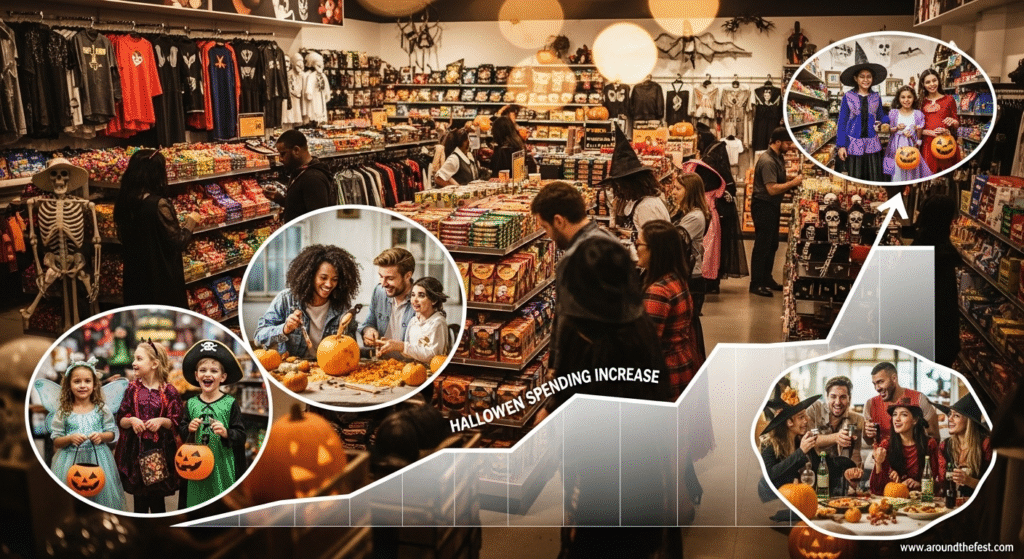 What began as small community rituals has now grown into a massive global celebration. In the context of this Halloween Essay in English, it’s important to recognize not only the cultural and historical significance of Halloween—but also its economic and social impact on modern society.
What began as small community rituals has now grown into a massive global celebration. In the context of this Halloween Essay in English, it’s important to recognize not only the cultural and historical significance of Halloween—but also its economic and social impact on modern society.
At the same time, awareness is rising about sustainability and inclusivity. Homemade costumes, recycled decor, and neighborhood allergy-safe events are becoming popular. Many communities host sensory-friendly Halloween celebrations so everyone can join in safely.
A Multi-Billion Dollar Industry
In countries like the United States, Halloween has become a major driver of seasonal spending. According to the National Retail Federation (NRF), Americans spent over $12.2 billion on Halloween-related items in 2024 alone—including costumes, decorations, candy, and themed entertainment.
Businesses—from retail chains and candy companies to haunted attractions and theme parks—experience a seasonal boom. Local artisans and small businesses also benefit, selling handmade costumes, spooky crafts, and festival food. This creates jobs, boosts sales, and energizes communities economically.
Key Areas of Halloween Spending:
• Costumes for children, adults, and pets
• Home and yard decorations
• Candy and treat bags
• Party supplies and makeup
• Haunted houses, escape rooms, and seasonal events
Social Impact and Community Connection
Beyond the money, Halloween plays a powerful social role. It encourages neighbors to interact—whether by handing out candy, joining street parades, or decorating homes together. Trick-or-treating, costume parties, and school events foster community bonding, especially among children and families.
In recent years, inclusive Halloween events have grown. Communities now host:
• Allergy-safe trick-or-treating (with teal pumpkins)
• Sensory-friendly haunted houses for neurodiverse participants
• Costume drives to ensure all kids can participate regardless of budget
These adaptations show how Halloween can be both festive and inclusive, reinforcing empathy, generosity, and shared joy.
Global Economic Adaptation
In many countries, Halloween has been adopted and localized—not just as an imported trend, but as an opportunity for local business and cultural expression. For example:
• In Japan, Halloween costume parades boost tourism and nightlife.
• In India, schools and clubs organize themed events and competitions.
• In Mexico, markets around Day of the Dead see a surge in handmade altars, sugar skulls, and traditional foods.
This economic-cultural fusion allows each region to benefit while celebrating in unique ways.
Why Students Should Explore Halloween

Historical Insight
Understanding Halloween helps connect ancient beliefs with modern society. It shows how traditions evolve and combine over time.
Creative Projects
Students can write stories, design costumes, explore folklore themes, or create artwork inspired by Halloween symbols.
Community Engagement
School celebrations and neighborhood events encourage safe creativity, bonding with peers, and celebrating shared traditions.
Reflection and Symbolism
Halloween offers a playful way to think about fear, memory, personal identity, and cultural blending—with deeper meanings embedded in snapshots of fun.
Through this Halloween Essay in English, students can explore both spooky fun and deep cultural roots.
Conclusion
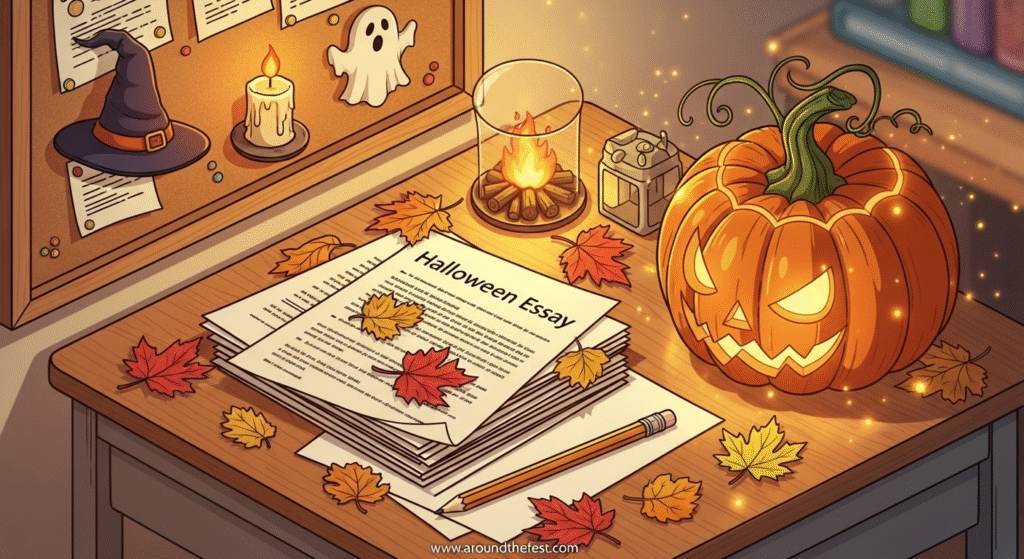
Halloween is much more than a night of fun costumes and candy. It is a living tradition—rooted in ancestral rituals, transformed by religion, and reinvented through generations. Whether you’re carving a pumpkin, watching costumes parade, or reading spooky tales, Halloween invites you to explore ancient stories, creative expression, and human connection.
This Halloween Essay in English offers a student-centered guide to understanding why this festival matters—and why it continues to enchant minds across cultures.
To make this Halloween Essay in English more helpful, here are answers to some common student questions:
FAQ Section- Halloween Essay in English

Q1. What does Halloween originally celebrate?
Ans. It began as a harvest-end ritual marking the thinning of the line between life and the spiritual world.
Q2. Why do people carve pumpkins?
Ans. To create talismans of light believed to protect against spirits—a practice now turned creative and decorative.
Q3. Where did trick-or-treat come from?
It evolved from ancient customs of seeking offerings or blessings, transforming into modern candy exchanges.
Q4. Is Halloween celebrated globally?
Ans. Yes! Even though traditions differ, many countries have similar fall festivals focused on remembrance or costume celebration.
Q5. How can students use Halloween in schoolwork?
Ans. Write themed essays, create artistic projects, perform stories, or organize lessons linking history, culture, and meaning.
Also read-
Halloween Essay For Kids
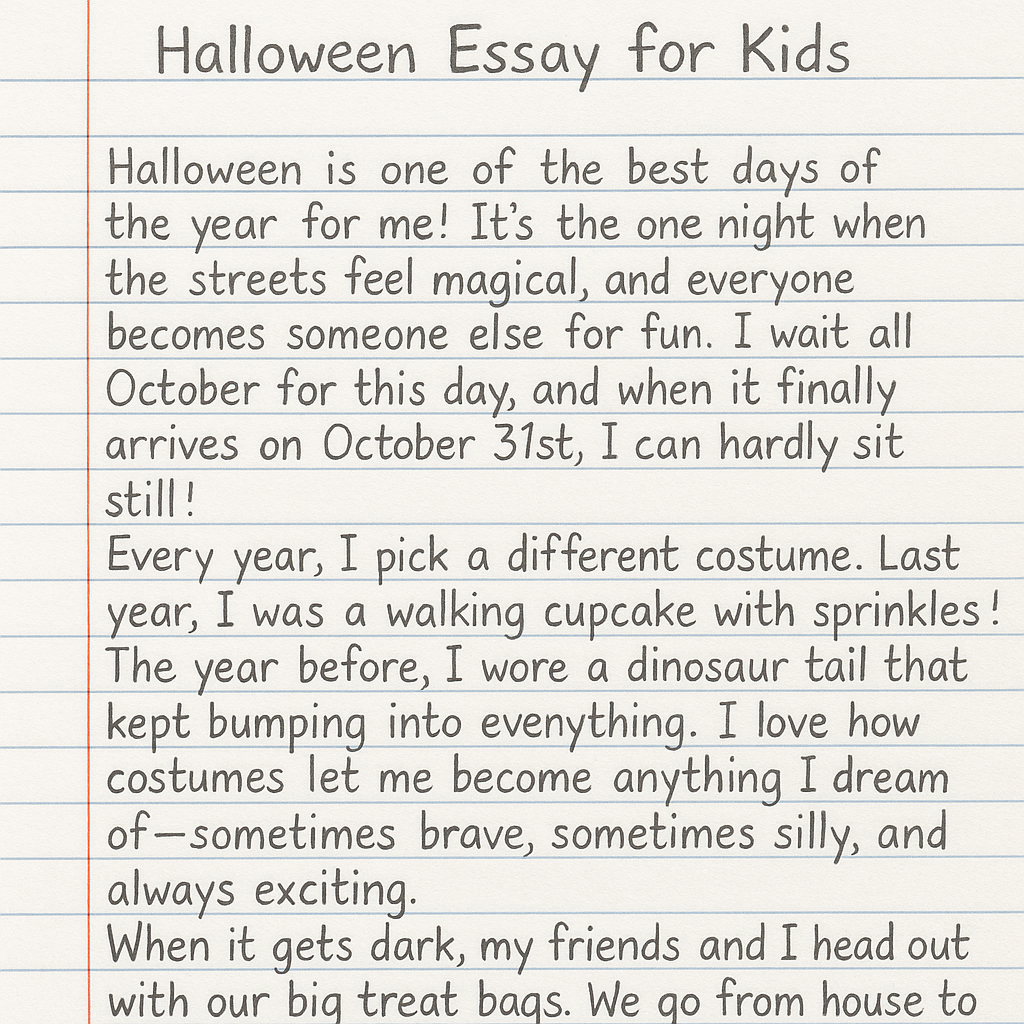
Halloween is one of the best days of the year for me! It’s the one night when the streets feel magical, and everyone becomes someone else for fun. I wait all October for this day, and when it finally arrives on October 31st, I can hardly sit still!
Every year, I pick a different costume. Last year, I was a walking cupcake with sprinkles! The year before, I wore a dinosaur tail that kept bumping into everything. I love how costumes let me become anything I dream of—sometimes brave, sometimes silly, and always exciting.
When it gets dark, my friends and I head out with our big treat bags. We go from house to house, saying “trick or treat!” with our biggest grins. Some houses are creepy—with glowing skeletons, spooky sounds, and giant spiders in the yard. But that just makes it more fun!
One of my favorite things is carving pumpkins with my family. We sit at the kitchen table, scooping out gooey insides and cutting funny faces. Then we drop a candle inside and turn off the lights. Boom! Our Jack-o’-lantern glows like magic.
At school, we have the best Halloween parties. We play games, do crafts, and eat snacks that look like eyeballs and mummies (but taste like cookies and sandwiches!). We laugh, dance, and show off our costumes to everyone.
Halloween isn’t just about candy—it’s about being creative, feeling brave, and having fun together. I love how everyone joins in—parents, teachers, neighbors, even my little dog who wore a bat costume once!
For me, Halloween feels like stepping into a story where I get to be the hero, the monster, or the mystery. That’s why it’s my favorite festival of all time.
That’s why Halloween is one of my favorite days of the year. I love every moment—spooky, sweet, and special!
